manual transmission RENAULT ESPACE 2000 J66 / 3.G Technical Note 3426A Workshop Manual
[x] Cancel search | Manufacturer: RENAULT, Model Year: 2000, Model line: ESPACE, Model: RENAULT ESPACE 2000 J66 / 3.GPages: 52, PDF Size: 0.98 MB
Page 2 of 52
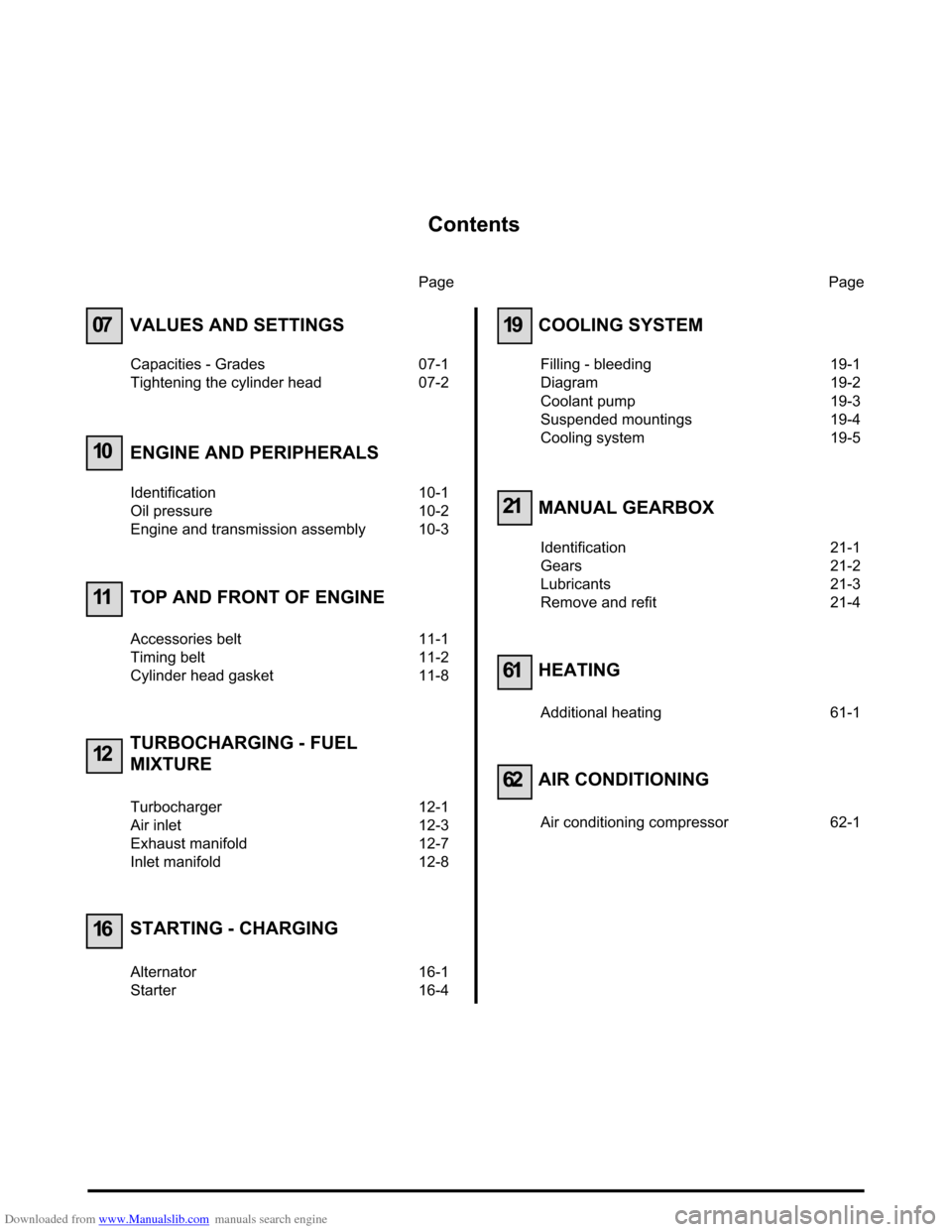
Downloaded from www.Manualslib.com manuals search engine Contents
Page
07
10
11
12
16
VALUES AND SETTINGS
Capacities - Grades 07-1
Tightening the cylinder head 07-2
ENGINE AND PERIPHERALS
Identification 10-1
Oil pressure 10-2
Engine and transmission assembly 10-3
TOP AND FRONT OF ENGINE
Accessories belt 11-1
Timing belt 11-2
Cylinder head gasket 11-8
TURBOCHARGING - FUEL
MIXTURE
Turbocharger 12-1
Air inlet 12-3
Exhaust manifold 12-7
Inlet manifold 12-8
STARTING - CHARGING
Alternator 16-1
Starter 16-4Page
19
21
61
62
COOLING SYSTEM
Filling - bleeding 19-1
Diagram 19-2
Coolant pump 19-3
Suspended mountings 19-4
Cooling system 19-5
MANUAL GEARBOX
Identification 21-1
Gears 21-2
Lubricants 21-3
Remove and refit 21-4
HEATING
Additional heating 61-1
AIR CONDITIONING
Air conditioning compressor 62-1
Page 4 of 52

Downloaded from www.Manualslib.com manuals search engine VALUES AND SETTINGS
Tightening the cylinder head
07
07-2
Tightening the cylinder head
METHOD FOR TIGHTENING THE CYLINDER HEAD
Consult manual Mot. G9 for the details of this
operation.You must remove the engine and transmission
assembly to remove the cylinder head
Page 7 of 52
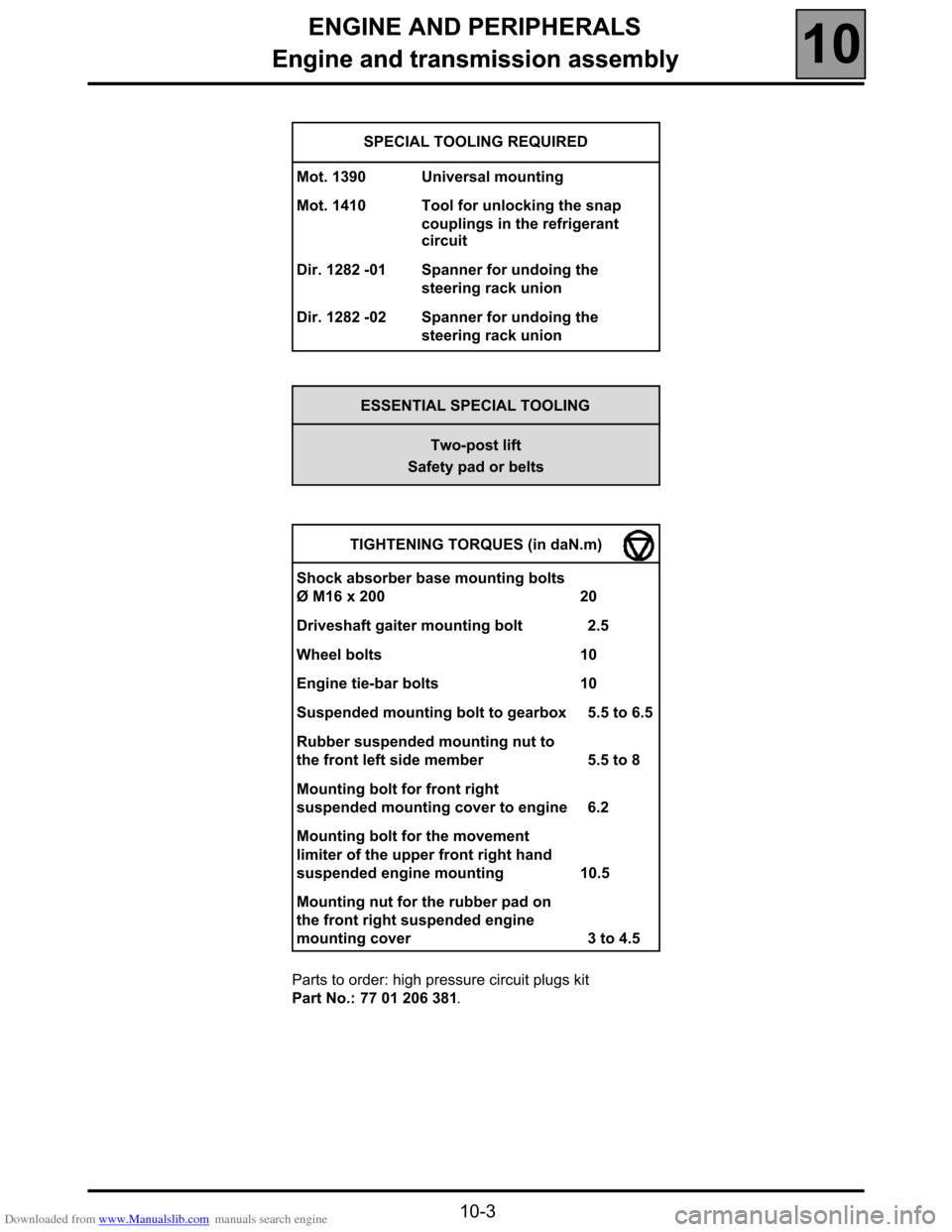
Downloaded from www.Manualslib.com manuals search engine ENGINE AND PERIPHERALS
Engine and transmission assembly
10
10-3
Engine and transmission assembly
Parts to order: high pressure circuit plugs kit
Part No.: 77 01 206 381. SPECIAL TOOLING REQUIRED
Mot. 1390 Universal mounting
Mot. 1410 Tool for unlocking the snap
couplings in the refrigerant
circuit
Dir. 1282 -01 Spanner for undoing the
steering rack union
Dir. 1282 -02 Spanner for undoing the
steering rack union
ESSENTIAL SPECIAL TOOLING
Two-post lift
Safety pad or belts
TIGHTENING TORQUES (in daN.m)
Shock absorber base mounting bolts
Ø M16 x 200 20
Driveshaft gaiter mounting bolt 2.5
Wheel bolts 10
Engine tie-bar bolts 10
Suspended mounting bolt to gearbox 5.5 to 6.5
Rubber suspended mounting nut to
the front left side member 5.5 to 8
Mounting bolt for front right
suspended mounting cover to engine 6.2
Mounting bolt for the movement
limiter of the upper front right hand
suspended engine mounting 10.5
Mounting nut for the rubber pad on
the front right suspended engine
mounting cover 3 to 4.5
Page 8 of 52
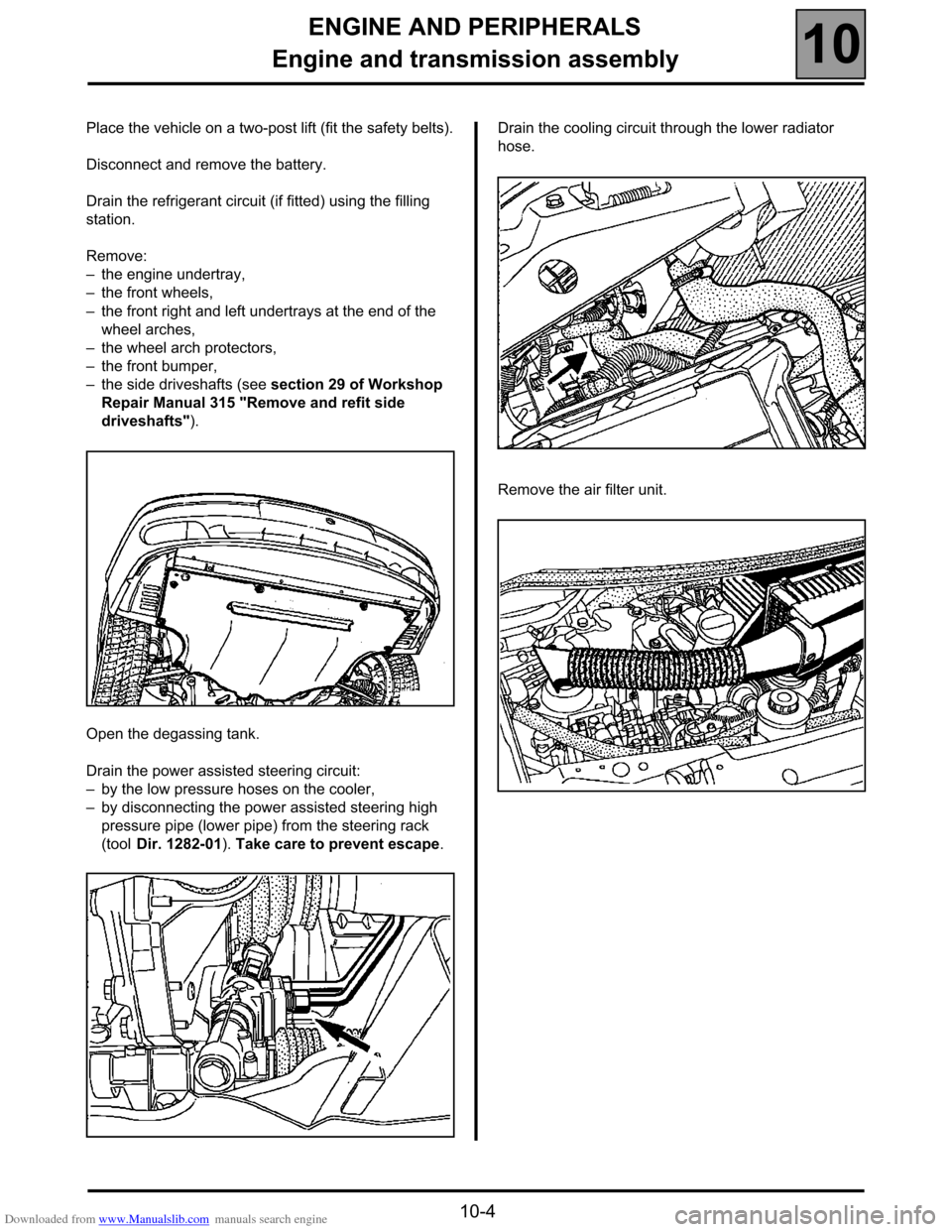
Downloaded from www.Manualslib.com manuals search engine ENGINE AND PERIPHERALS
Engine and transmission assembly
10
10-4
Place the vehicle on a two-post lift (fit the safety belts).
Disconnect and remove the battery.
Drain the refrigerant circuit (if fitted) using the filling
station.
Remove:
–the engine undertray,
–the front wheels,
–the front right and left undertrays at the end of the
wheel arches,
–the wheel arch protectors,
–the front bumper,
–the side driveshafts (see section 29 of Workshop
Repair Manual 315 "Remove and refit side
driveshafts").
Open the degassing tank.
Drain the power assisted steering circuit:
–by the low pressure hoses on the cooler,
–by disconnecting the power assisted steering high
pressure pipe (lower pipe) from the steering rack
(tool Dir. 1282-01). Take care to prevent escape.Drain the cooling circuit through the lower radiator
hose.
Remove the air filter unit.
Page 9 of 52
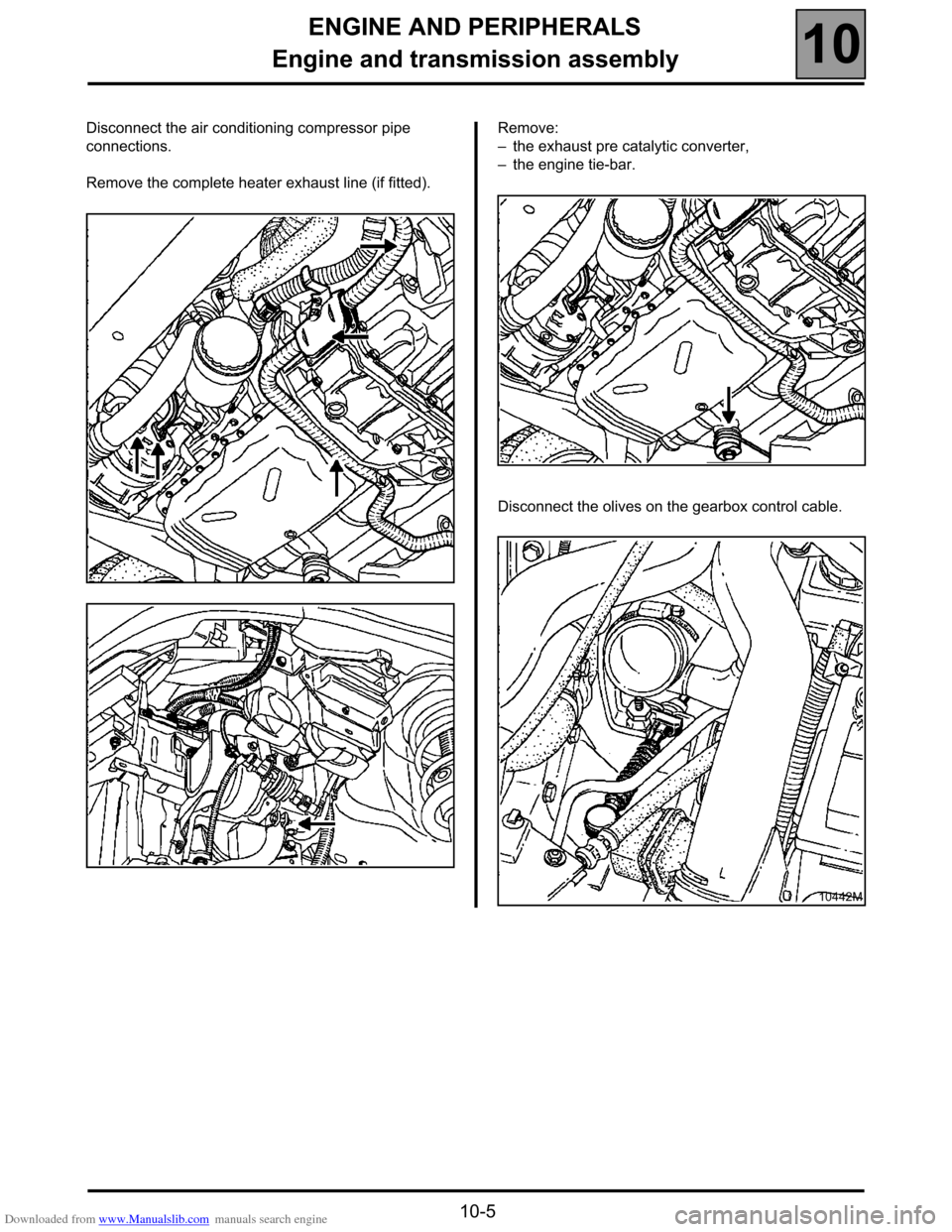
Downloaded from www.Manualslib.com manuals search engine ENGINE AND PERIPHERALS
Engine and transmission assembly
10
10-5
Disconnect the air conditioning compressor pipe
connections.
Remove the complete heater exhaust line (if fitted).Remove:
–the exhaust pre catalytic converter,
–the engine tie-bar.
Disconnect the olives on the gearbox control cable.
10442M
Page 10 of 52
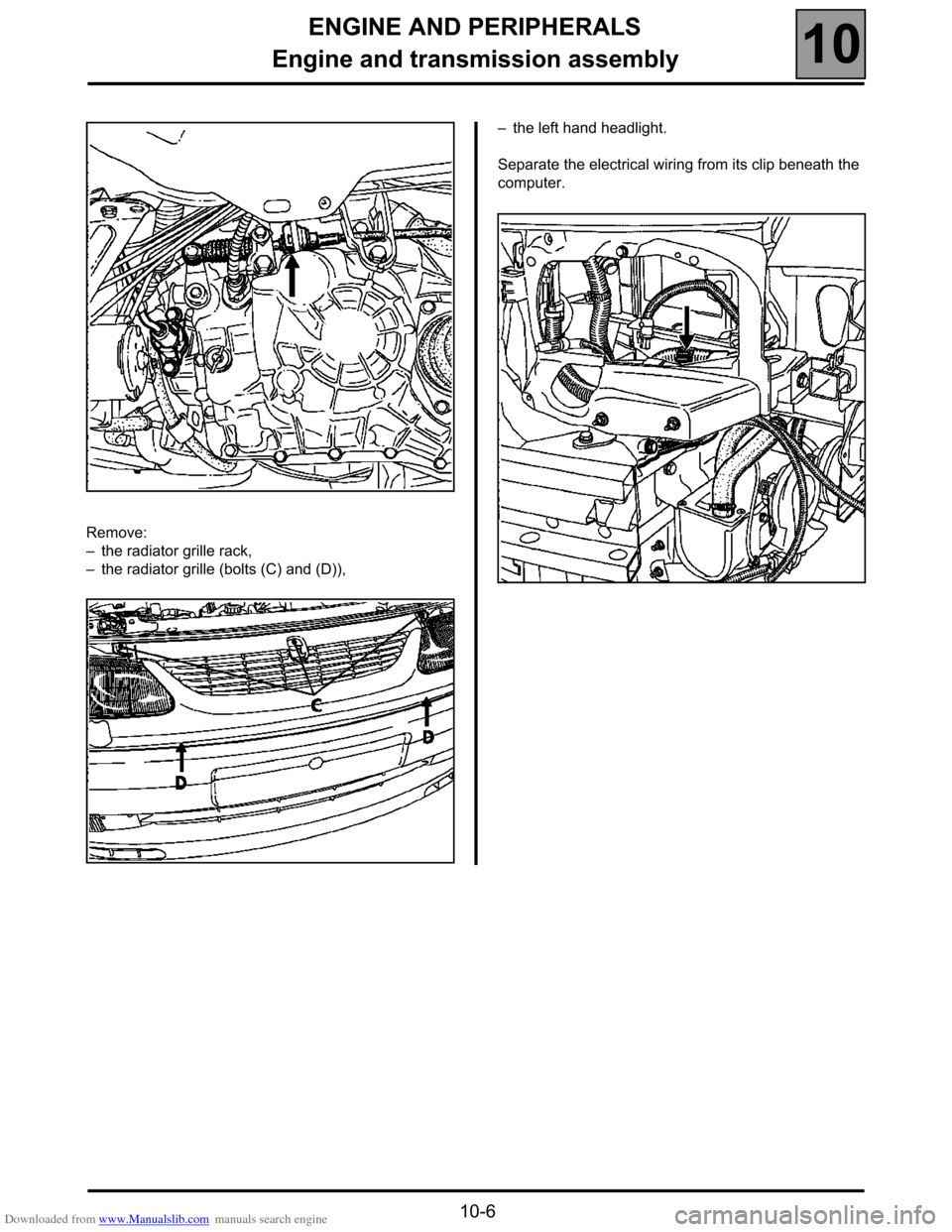
Downloaded from www.Manualslib.com manuals search engine ENGINE AND PERIPHERALS
Engine and transmission assembly
10
10-6
Remove:
–the radiator grille rack,
–the radiator grille (bolts (C) and (D)),–the left hand headlight.
Separate the electrical wiring from its clip beneath the
computer.
Page 11 of 52
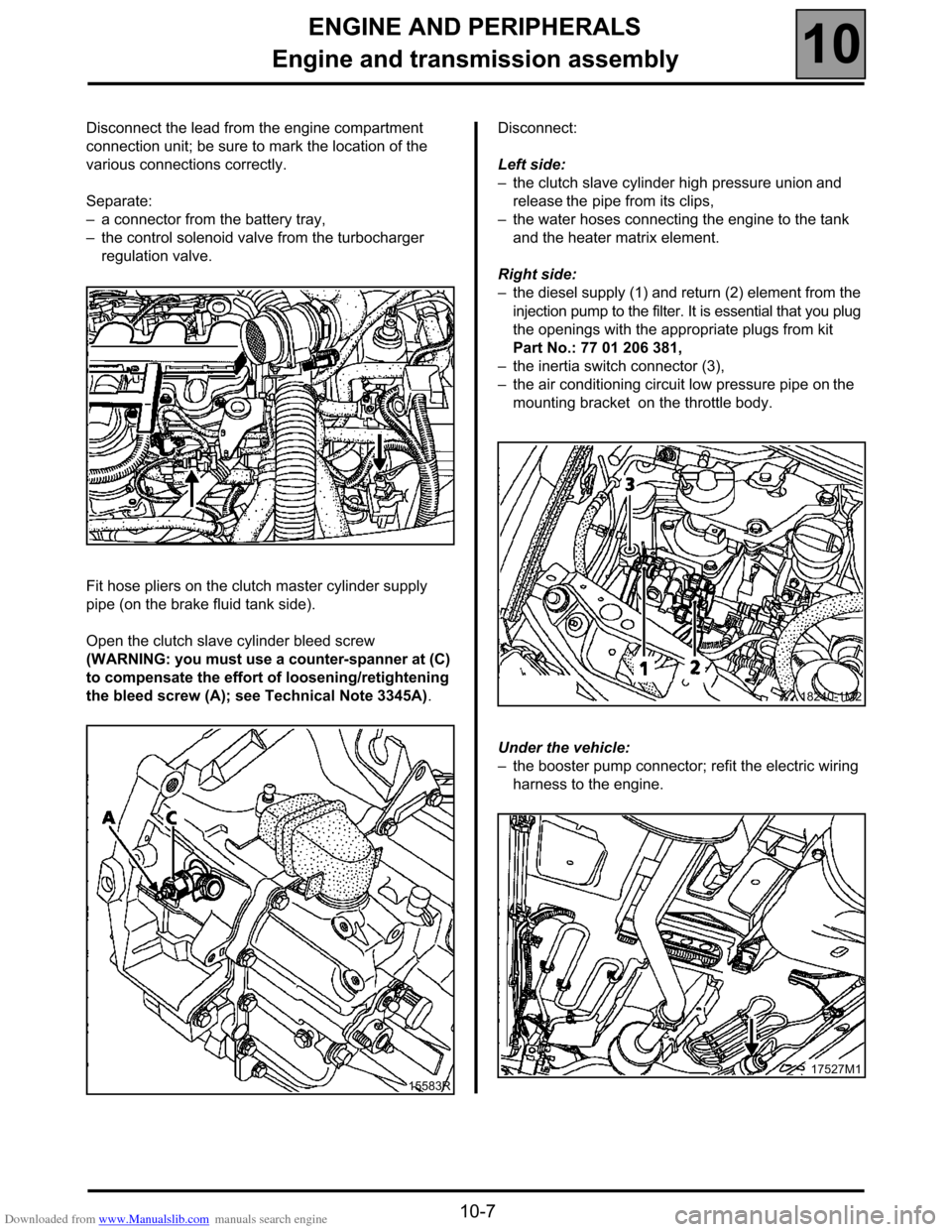
Downloaded from www.Manualslib.com manuals search engine ENGINE AND PERIPHERALS
Engine and transmission assembly
10
10-7
Disconnect the lead from the engine compartment
connection unit; be sure to mark the location of the
various connections correctly.
Separate:
–a connector from the battery tray,
–the control solenoid valve from the turbocharger
regulation valve.
Fit hose pliers on the clutch master cylinder supply
pipe (on the brake fluid tank side).
Open the clutch slave cylinder bleed screw
(WARNING: you must use a counter-spanner at (C)
to compensate the effort of loosening/retightening
the bleed screw (A); see Technical Note 3345A).Disconnect:
Left side:
–the clutch slave cylinder high pressure union and
release the pipe from its clips,
–the water hoses connecting the engine to the tank
and the heater matrix element.
Right side:
–the diesel supply (1) and return (2) element from the
injection pump to the filter. It is essential that you plug
the openings with the appropriate plugs from kit
Part No.: 77 01 206 381,
–the inertia switch connector (3),
–the air conditioning circuit low pressure pipe on the
mounting bracket on the throttle body.
Under the vehicle:
–the booster pump connector; refit the electric wiring
harness to the engine.
15583R
18240-1M2
17527M1
Page 12 of 52
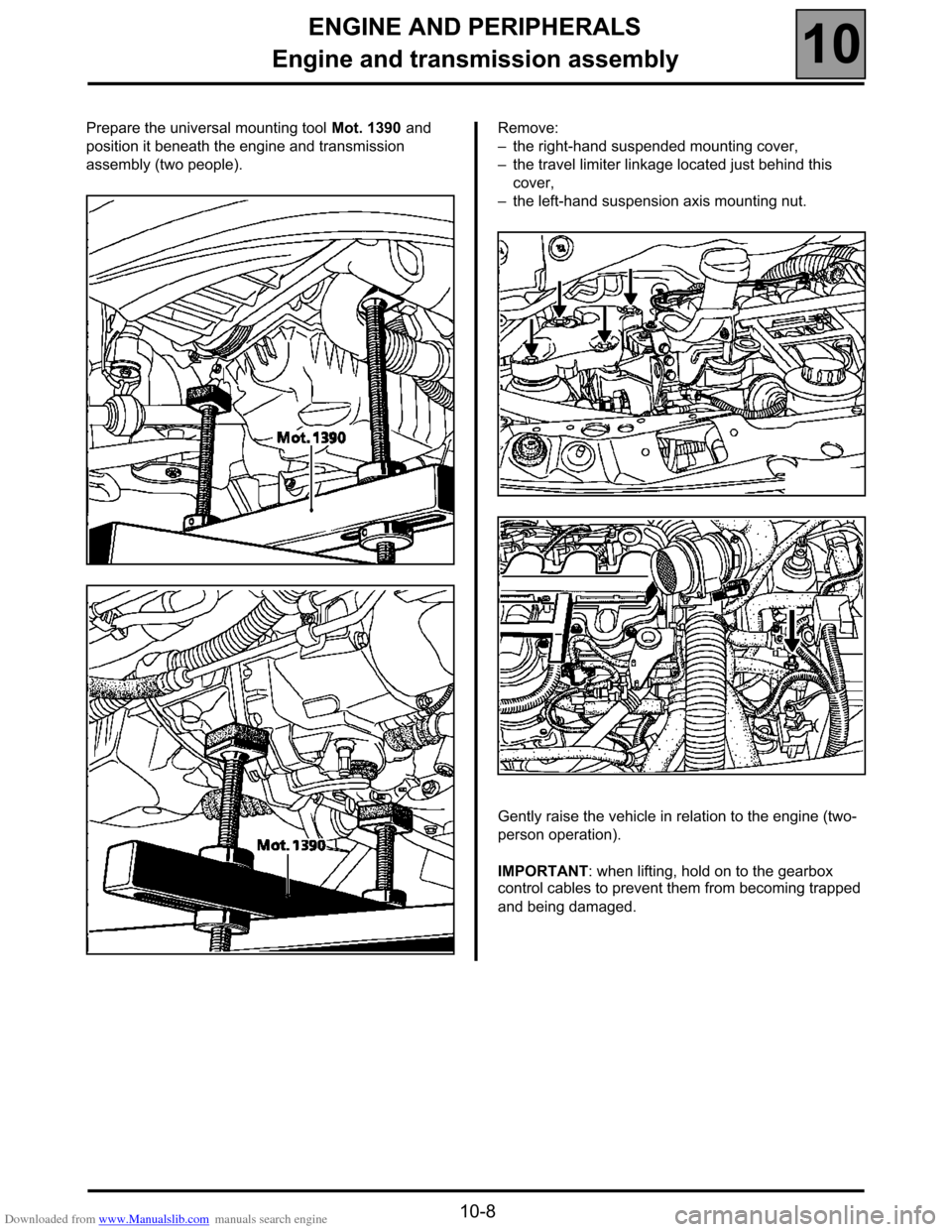
Downloaded from www.Manualslib.com manuals search engine ENGINE AND PERIPHERALS
Engine and transmission assembly
10
10-8
Prepare the universal mounting tool Mot. 1390 and
position it beneath the engine and transmission
assembly (two people).Remove:
–the right-hand suspended mounting cover,
–the travel limiter linkage located just behind this
cover,
–the left-hand suspension axis mounting nut.
Gently raise the vehicle in relation to the engine (two-
person operation).
IMPORTANT: when lifting, hold on to the gearbox
control cables to prevent them from becoming trapped
and being damaged.
14935M1
Page 13 of 52
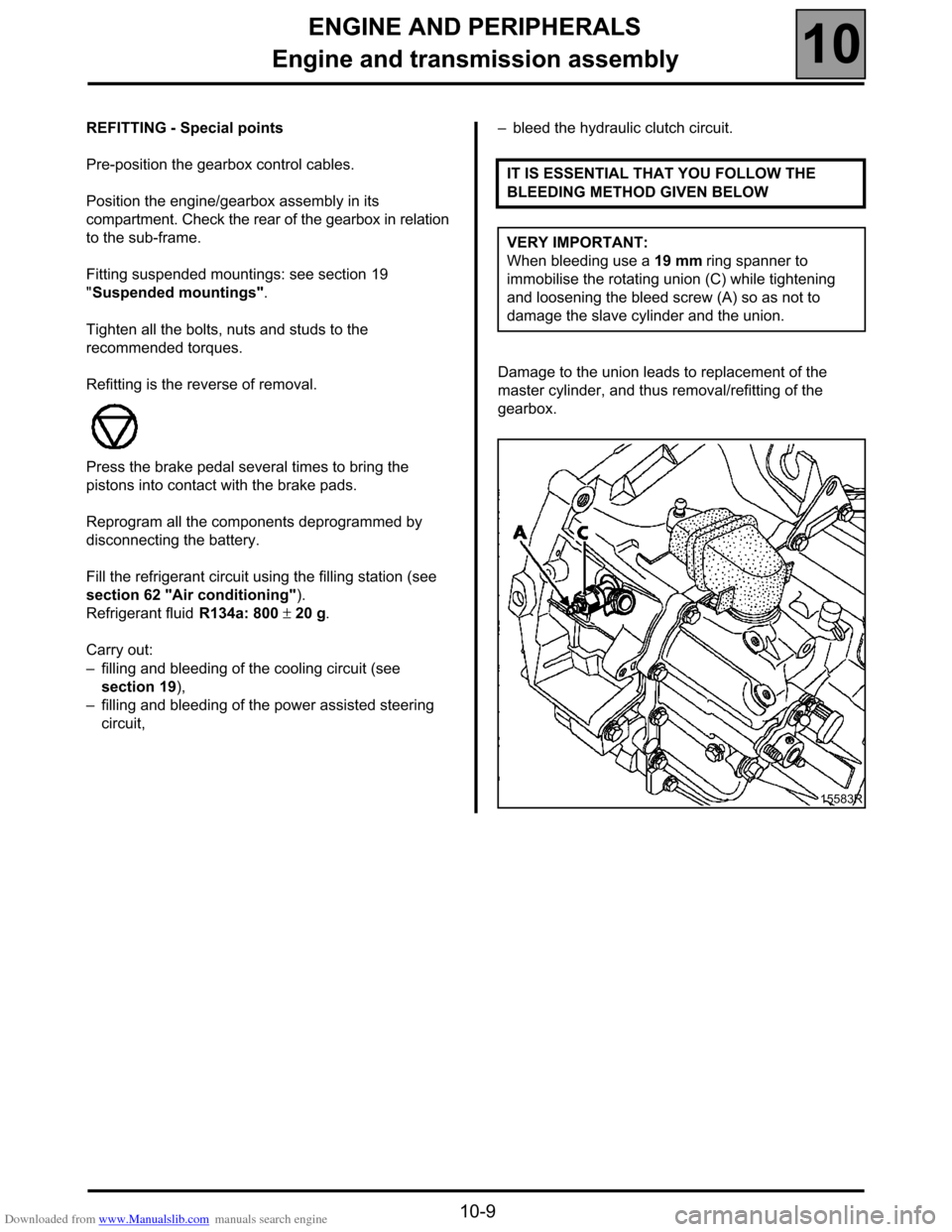
Downloaded from www.Manualslib.com manuals search engine ENGINE AND PERIPHERALS
Engine and transmission assembly
10
10-9
REFITTING - Special points
Pre-position the gearbox control cables.
Position the engine/gearbox assembly in its
compartment. Check the rear of the gearbox in relation
to the sub-frame.
Fitting suspended mountings: see section 19
"Suspended mountings".
Tighten all the bolts, nuts and studs to the
recommended torques.
Refitting is the reverse of removal.
Press the brake pedal several times to bring the
pistons into contact with the brake pads.
Reprogram all the components deprogrammed by
disconnecting the battery.
Fill the refrigerant circuit using the filling station (see
section 62 "Air conditioning").
Refrigerant fluid R134a: 800 ± 20 g.
Carry out:
–filling and bleeding of the cooling circuit (see
section 19),
–filling and bleeding of the power assisted steering
circuit,–bleed the hydraulic clutch circuit.
Damage to the union leads to replacement of the
master cylinder, and thus removal/refitting of the
gearbox.IT IS ESSENTIAL THAT YOU FOLLOW THE
BLEEDING METHOD GIVEN BELOW
VERY IMPORTANT:
When bleeding use a 19 mm ring spanner to
immobilise the rotating union (C) while tightening
and loosening the bleed screw (A) so as not to
damage the slave cylinder and the union.
15583R
Page 14 of 52

Downloaded from www.Manualslib.com manuals search engine ENGINE AND PERIPHERALS
Engine and transmission assembly
10
10-10
BLEEDING METHOD TO BE USED:
(for two people).
1) Filling the circuit:
Check that the clutch pedal is in the top position; put
it in this position and hold it by hand if necessary.
Fill the hydraulic circuit by connecting a filling system
and applying pressure to the tank, open the bleed
screw (A) (always compensate for the force using a
counter-spanner) and allow a little fluid to escape
(approximately 0.5 l) through a transparent tube
connected to the bleed screw. Close the bleed
screw.
2) Final bleeding of the circuit:
One operator slowly disengages fully and keeps the
pedal depressed. Wait approximately ten seconds in
this situation. With the pedal still depressed, a
second operator opens the bleed screw briefly (A).
With the bleed screw closed again, the operator
inside the vehicle releases the clutch pedal and
slowly lifts it to top position by hand (It is normal that
the pedal does not return independently in this
configuration).
After a few seconds repeat the operations described
above in 2) as often as required until no more
bubbles escape when bleeding. Then repeat these
operations five times to ensure that the system has
been bled correctly.
These repeated bleedings allow the slave cylinder to
eject all the air trapped in any section between the
stop and the bleed screw and which has not been
"cleaned" by the flow of liquid when refilling using the
traditional pressurisation system.
An air bubble in the circuit, no matter how small, may
lead to operating faults such as: incorrect pedal
return, crashing of the gears,..., which may lead to
incorrect fault finding and unnecessary replacement
of a component in the clutch circuit.